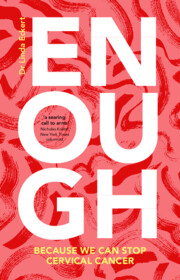Book contents
- Enough
- Reviews
- Enough
- Copyright page
- Dedication
- Contents
- Figures
- The Calling
- Part One A Preventable Cancer
- Part Two The Science behind Cervical Cancer
- 4 The Dangerous Clout of a Sexually Transmitted Virus
- 5 The Power of Prevention
- 6 The Toll of Treatment
- 7 Gasoline on the Fire: When HIV Meets HPV
- Part Three The Prevention Problem
- Part Four Getting to Enough
- Acknowledgments
- Reader Resources
- References
- Index
6 - The Toll of Treatment
from Part Two - The Science behind Cervical Cancer
Published online by Cambridge University Press: 11 January 2024
- Enough
- Reviews
- Enough
- Copyright page
- Dedication
- Contents
- Figures
- The Calling
- Part One A Preventable Cancer
- Part Two The Science behind Cervical Cancer
- 4 The Dangerous Clout of a Sexually Transmitted Virus
- 5 The Power of Prevention
- 6 The Toll of Treatment
- 7 Gasoline on the Fire: When HIV Meets HPV
- Part Three The Prevention Problem
- Part Four Getting to Enough
- Acknowledgments
- Reader Resources
- References
- Index
Summary
Every year, more than 600,000 persons with cervixes end up with cervical cancer. Without treatment, these people will die. And yet, treatment for cervical cancer remains is scarce enough in lower-income countries to typically make a cervical cancer diagnosis a terminal one. Women who can’t afford to travel for their treatment are left to die painful, lonely deaths, stigmatized, and with next-to-no palliative care. In higher-income countries, surgery, radiation, chemotherapy, as well as immunotherapy can prolong or even save lives. But these treatments can be arduous and even torturous, with life-altering consequences, such as loss of fertility and physical disfigurement, along with chronic or debilitating health conditions and radical lifestyle changes. In affluent regions, treatment is often seen as a last-ditch option, while marginalized women around the globe consider it a luxury. Cervical cancer prevention is the most cost-effective, sustainable, and humane approach toward eliminating the disease. But until treatment can be offered equitably alongside prevention, thousands more will suffer and die.
Keywords
- Type
- Chapter
- Information
- EnoughBecause We Can Stop Cervical Cancer, pp. 66 - 79Publisher: Cambridge University PressPrint publication year: 2024



